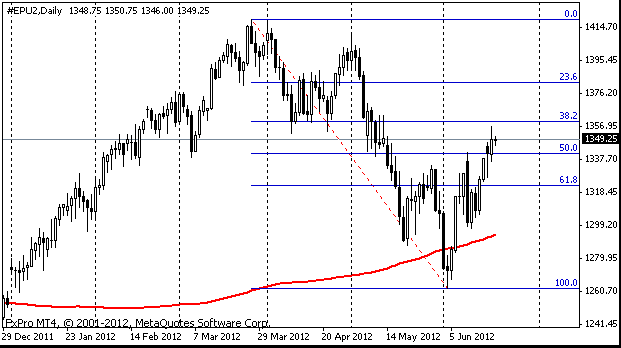EUR/usd
Last week's rally was supported by the markets partly on expectations of further actions from two largest CBs – the ECB and Fed. However, Friday's data on the GDP level and other relatively neutral statistics made the markets temper their expectations. In the anticipation of the Fed's meeting minutes the average market forecast is inclined towards the status-quo preservation. Almost 90% of economists and market analysts, surveyed by Bloomberg, don't expect the launch of QE3 today. It is believed that tonight the Fed will highlight the ways to ease the policy, changing some phrases in the commentaries, but will take real action only in September. Yesterday we mentioned that Bernanke could launch programmes of economy stimulation preventively, without waiting for the actual decline of the GDP. The same thing was in 2011, when Operation Twist was launched in the strongest quarter, which then, however, was followed by a rather slack growth. Now Bernanke has to outstrip the fiscal austerity, which will inevitably be in place at the end of the year. The fiscal cliff is now estimated at about $ 600bln. Many, including us, see this figure as a good benchmark to assess the size of the third round of quantitative easing. The single currency and most markets, however, are trading flat. The slight decline on Monday was fully recouped on Tuesday, when EUR/USD grew from 1.2260 to 1.2330. This night we saw a few sell-offs emerging, but by the start of the EU session the single currency again jumped above 1.23. Yesterday's US statistics were rather contradictory. On the one hand, we can observe a growing tendency among Americans to save, as with the income growth for the 7th month in a row spending shrank in May and remained unchanged in June. Partly it is connected with the decline of fuel prices. However, this factor won't have a long-lasting effect. Already now we have at hand reports about the first in many weeks growth of fuel prices. It means that in July American spending inevitably increased. The S&P/Case-Shiller Home Price Index has grown significantly since the start of the year. In May the prices grew by another 0.9% after the 0.7% increase a month before. The annual performance is already at -0.66% after –4.05% recorded in December. Even if it is early to speak about a reversal now, price stabilization is a sure thing.

GBP/USD
After all the British pound has started a slight correction. Now the sterling is a bit below 1.57. In the quiet market traders prefer to take profits from the previous rally in the pound. To break the resistance of the side channel, there should be a really weighty reason. It can be an extraordinary market volatility caused by Bernanke's statement. But as has already been mentioned, it's hardly worth expecting any new steps from the American CB today. Basically it will be surprising for the markets and destructive for Britain, if the BoE holds aloof, while the ECB and Fed will be easing their policy. Barclays and BNP have already announced that in November the interest rate is expected to be cut down to 0.25%. Is it the time to sell the pound?

After reaching higher maximums on Monday, the stock exchanges have taken up a defensive position and corrected part of the growth. You shouldn't be afraid of this, as on expectations of a strong move players prefer to gain liquidity, reducing the number of their opened positions. In the charts it is generally shown as a shift from extremums. Staking on the possible move of S&P 500towards the lower boundary of the upward channel, we can suggest that this move will target 1335 by the end of the week. However, for this to happen there should be some disappointment in the Fed's dicision, slight dissatisfaction with draghi and moderately poor payrolls on Friday.

USD/CAD
Unlike the pound, the Canadian loonie enjoys demand in the quiet market. A slight disappointment in the GDP data for May (growth by 0.1% m/m and 2.4% y/y) stimulated selling of CAD just for a couple of hours. Already this morning the purchases of the Loonie have resumed. Such interest in Canada is largely caused by active asset diversification by CBs. For example, the SNB has more than doubled the share of ‘minor' assets in its reserves.
